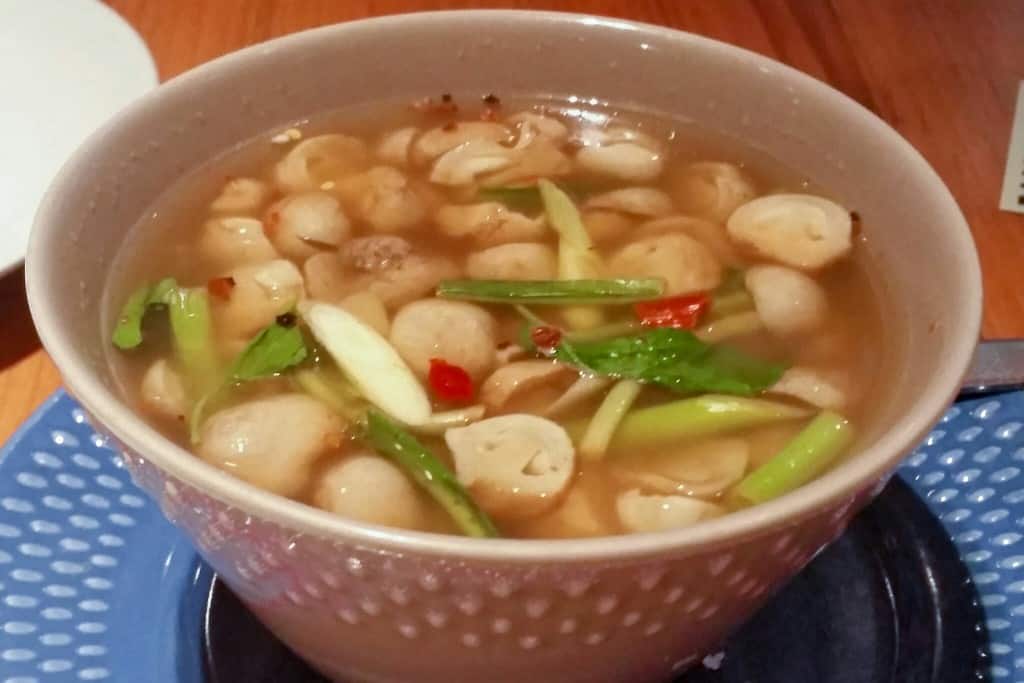เจ, pronounced a little bit like the halfway point between 'jay' and 'jee,' roughly translates to 'vegan' in Thai. Each year a nine day vegetarian festival is held across the country, more pronounced in some areas than others, that celebrates a je diet. The event is large and unmissable if you are in towns or cities in Thailand that choose to participate, with vegan food marked and readily available in convenience stores, on the street, and on special festival-only menus at restaurants.
This is my fourth or fifth time being in Thailand during the festival, and there are a few points that always stand out. One is the confusion between the fine line distinguishing Thai and Chinese (Thai Chinese) food, and the fact that the latter takes centre stage if you aren't paying attention to what's happening behind the scenes. Noodle soups, steamed buns, dumplings, and many of the handhelds seen at je street stalls are the more Chinese influenced snacks. These bites are delicious, filling, and easy to access, but barely scrape the surface of what Thai food is about.
Should you be fortunate enough to find yourself in Southeast Asia during the vegetarian festival (or outside, if you look carefully), here are seven Thai vegan foods to try in Thailand:
1. Tom saap soup
The often spicier cousin of tom kha (also sour and salty), tom saap hails vaguely from Thailand's Northeastern Isaan region. Find vegan versions at Isaan restaurants with เจ or vegetarian menus, or try requesting it by asking the chef to omit fish sauce and use vegetables and/or tofu in place of animal protein.
2. Khao laam
Khao laam is sticky rice (white or black) mixed with a little sugar and coconut milk that is packed into bamboo tubes and grilled. Sometimes a few beans or chunks of taro are added.
3. O-tao
I have only ever seen o-tao in Phuket and have asked many Thais in Bangkok about this dish. The response is always the same: it looks like a local specialty. A ladle of rice flour and coconut milk slurry is added to a hot cooking plate, broken apart with a wok spoon, and stir fried with mushrooms (straw and wood ear), chili sauce, bean sprouts, tofu, and beans. A final healthy dusting of white pepper is added, along with fried TVP pieces upon dishing up. It is spicy, gummy, and crunchy.
4. Pak kad dong and other dishes with rice
A popular style of eating Thai food, especially at je restaurants, is to select 2-3 dishes to consume with rice. There might be anywhere between 5 and 50 options, depending on the operation, but one of my favourites (especially paired with a sweet and a spicy option) is pak kad dong. This translates to stir fried pickled mustard greens.
You can try my recipe for pak kad dong tofu if you're interested.
5. Naem het
Naem are Thai fermented pork sausages, but there are also mushroom (het) variations found during the festival and at เจ markets. Finely shredded mushroom is fermented with salt, rice, and a combination of other ingredients to obtain a sour flavour. Sometimes a tiny mean chili called prik kee noo is tucked deceptively inside, and will cause convulsions (I gifted some naem het to my Thai teacher and she nearly cried after happening upon a prik kee noo).
Like mice, prik kee noo can hide themselves well until you find evidence of their presence, but once you're aware they are lurking you're all "WHAT?! NO. AHHHH!" Prik translates to chili, kee to shit, and noo means mouse, so the name literally translates to mouse shit chilies. Fitting.
6. Kanom jeen
If you know me, you know my love for kanom jeen. These fermented rice noodles are the only noodles eaten with curry in Thailand, and are a popular breakfast item on the streets. You simple choose the curry, or mix of curries, you want, and the vendor will spoon some over a plate of these sticky room temperature noodles. A multitude of condiments always accompany kanoom jeen, which is meant to be eaten with plenty of fresh vegetables, herbs, pickles, and other condiments. In fact you could almost look at the noodles and curry as a side to the fresh produce.
The two most common curries with kanom jeen include nam yaa, which is very spicy and has a rich medicinal flavour due to the addition of grachai (finger root), and nam phrik. Nam phrik is sweet and nutty, made with peanuts or roasted mung beans. They are beautiful when combined.
7. Roti sai mai
A mix between western fairground candy floss and the Turkish floury variety, roti sai mai consists of hand pulled candied sugar that, after a lot of manual labour, eventually separates into strands that resemble hair (one friend refers to roti sai mai as hair pancakes). The spun sugar is wrapped in unsweetened fresh roti pancakes (normally made from just flour, salt, and water blended with pandan).
You can find roti sai mai in Ayutthaya (an hour out of Bangkok) at any time or on multiple stalls on Yaoworat (Bangkok Chinatown) or on Phuket during the vegetarian festival.
